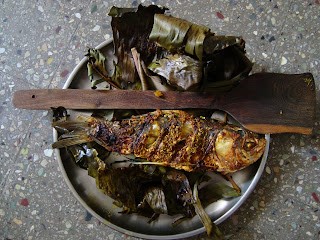Paatot Diya Maas is a traditional Assamese dish where fish is marinated in aromatic spices, wrapped in banana leaves, and then grilled or steamed. This cooking method infuses the fish with the earthy flavor of the banana leaves, resulting in a richly flavorful dish cherished by generations.
If you are looking to experience authentic Assamese cuisine, Paatot Diya Maas is a must-try! The term ‘Paatot’ means wrapped in a leaf, while ‘Maas’ means fish. As the name suggests, this dish features marinated fish wrapped in banana leaves and cooked over low heat, either by roasting or steaming. The banana leaves not only help keep the fish moist and tender but also add a subtle earthy flavor, enhancing the dish’s overall taste.
Health Benefits
Cooking fish in banana leaves is both a flavorful and healthy technique. Here are some advantages of this method:
- Nutrient Preservation: The banana leaf helps lock in the fish’s natural moisture, ensuring that nutrients such as omega-3 fatty acids, vitamins, and minerals are preserved.
- No Added Fat: This method requires little to no oil, making it a low-calorie option.
- Banana Leaf Benefits: Rich in antioxidants, the banana leaf also imparts a subtle flavor to the fish, enhancing its health benefits.

Ingredients & Recipe for Paatot Diya Maas
This dish requires just a few simple ingredients, many of which are staples in Assamese households.
Main Ingredients:
- Fish – 4 pieces (small to medium-sized fish like Rohu, Catla, or Bhetki work best)
- Banana leaves – 4 large pieces (cleaned and wilted)
For the Marinade:
- Mustard seeds – 2 tablespoons (ground into a paste)
- Turmeric powder – 1/2 teaspoon
- Green chilies – 2-3 (adjust to taste)
- Ginger-garlic paste – 1 tablespoon
- Mustard oil – 2 tablespoons
- Salt – to taste
- Coriander leaves – a handful (chopped)
Recipe:
Step 1: Preparing the Banana Leaves
Begin by gently heating the banana leaves over an open flame or in a hot pan to make them soft and pliable. This helps prevent tearing when wrapping the fish. Rinse the leaves thoroughly and cut them into large pieces, ensuring they are big enough to encase each fish piece.
Step 2: Marinating the Fish
Clean and wash the fish pieces, then pat them dry with a paper towel. In a bowl, prepare the marinade by mixing the ground mustard seed paste, turmeric powder, ginger-garlic paste, green chilies, mustard oil, and salt. Evenly coat the fish pieces with the marinade and let them rest for 15-20 minutes to absorb the flavors.
Step 3: Wrapping the Fish
Place one marinated fish piece on a banana leaf. Sprinkle a few chopped coriander leaves on top for added flavor. Carefully fold the banana leaf over the fish to create a neat parcel, securing it with toothpicks or tying it with kitchen twine.
Step 4: Cooking the Paatot Diya Maas
There are two popular methods for cooking the fish parcels:
- Steaming: Place the wrapped fish in a steamer and steam for about 20-25 minutes until the fish is fully cooked.
- Roasting: Heat a flat pan and place the wrapped fish parcels on it. Cook on low heat, turning occasionally, for about 15-20 minutes, making sure the banana leaves do not burn.
Step 5: Serving
After cooking, carefully unwrap the banana leaves to reveal the tender and flavorful fish inside. Serve the Paatot Diya Maas hot, accompanied by steamed rice and a side of mustard oil for an authentic Assamese experience.
Summing Up:
The charm of Paatot Diya Maas lies in its blend of simple ingredients, traditional cooking techniques, and the use of banana leaves. This dish is deeply ingrained in the Assamese way of life, particularly in rural areas where bananas are plentiful and traditional culinary methods are still upheld. It offers a delightful balance of flavors—sweet, earthy, and aromatic—without overwhelming spices, allowing the natural taste of the fish to take center stage.









